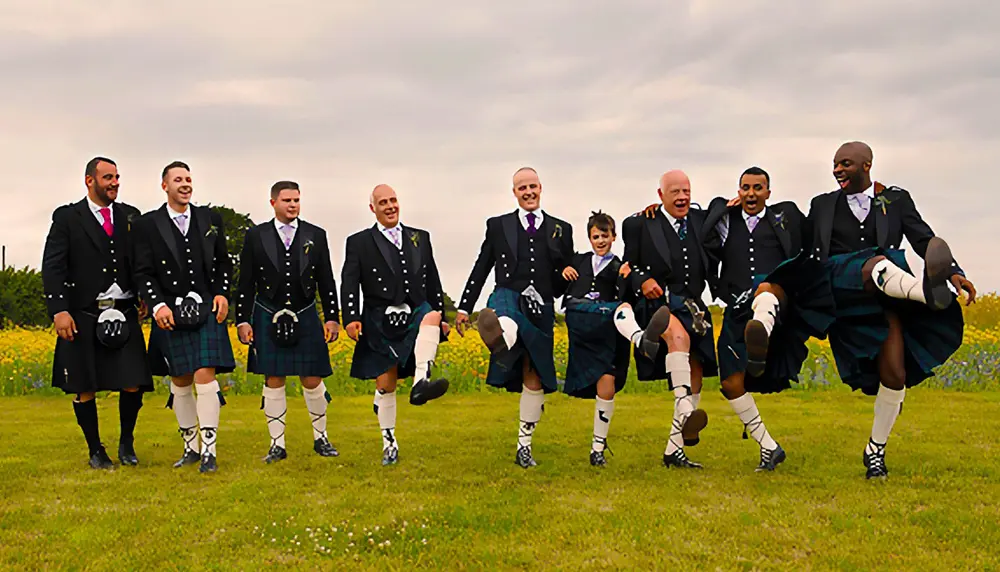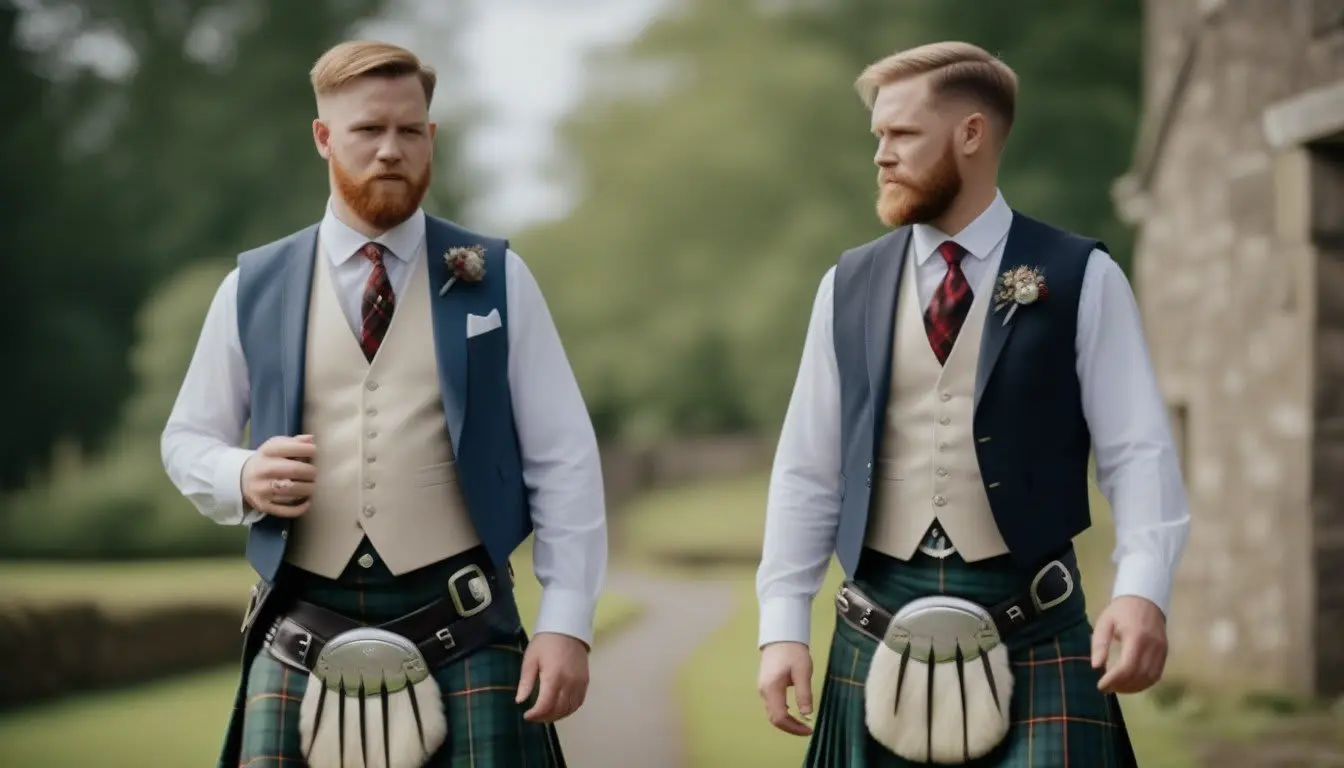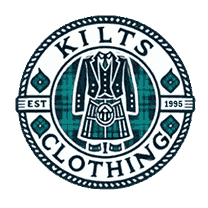How to Wear a Kilt: A Comprehensive Guide

Mens Kilt are more than just garments; they embody Scottish heritage and offer a distinctive style that stands out in various settings. Whether preparing for a traditional Scottish celebration, a wedding, or embracing a unique fashion statement, knowing how to wear a kilt properly is crucial.
This guide will walk you through everything you need about kilt clothing, from choosing the right kilt to accessorizing for the perfect look.
Understanding the Kilt: A Brief Overview
Before diving into the nuances of mens kilt-wearing, it’s important to understand the garment’s origins and cultural significance. This will provide a solid foundation for appreciating and wearing a kilt with respect.
What is a Kilt?
A kilt is a knee-length, skirt-like garment with pleats at the back, traditionally made from woollen cloth in a distinctive tartan pattern.
Known as kilt clothing, it is designed for comfort and style, offering freedom of movement and a unique appearance. Traditionally worn by Scottish Highlanders, kilts have evolved into a versatile fashion piece.
Historical Significance
Kilts have been a staple of Scottish attire for centuries, symbolizing clan identities and cultural pride. Historically, Scottish Highlanders wore kilts as part of their daily life, and today, they continue to be a prominent part of Scottish and Irish celebrations. Despite their origins, the kilt has transcended its traditional roots and is now embraced in various contexts worldwide.
Choosing the Right Kilt for You
Selecting the perfect kilt involves considering several factors to ensure it fits and complements your style whether it is mens utility kilts or other. Here’s how to choose the right kilt for you.
Fabric and Tartan Patterns
When choosing a kilt, fabric and tartan patterns are crucial. Traditional kilts are made from wool, known for its durability and classic look. Modern variations may use synthetic fabrics for added comfort.
Your tartan pattern can reflect personal taste, clan affiliation, or regional pride. Popular tartans include the Royal Stewart and Black Watch, among others. For those interested in Scottish kilt skirts or Irish kilts, there are numerous patterns to explore.
Custom vs. Off-the-Shelf Kilts
Deciding between custom kilts and off-the-shelf options depends on your preference and budget. Custom kilts offer a tailored fit and can be designed to your specifications, ideal for formal occasions like weddings.
Off-the-shelf men kilt are more readily available and can be a cost-effective solution. Both options can provide a stylish kilt, but custom options allow for greater personalization.
Kilt Length and Fit
The length and fit of your kilt are essential for achieving the traditional look and ensuring comfort. Ideally, a kilt should fall just above the knee, allowing for ease of movement while maintaining a classic silhouette. The waistband should fit comfortably around your waist, avoiding tightness or looseness. Proper fit ensures that your kilt looks sharp and feels great.
How to Wear a Kilt: Step-by-Step Instructions
Wearing a kilt involves more than just putting it on; it’s about mastering the traditional techniques that enhance comfort and style. Follow these steps to wear your kilt like a pro.
Putting On the Kilt
1. Start with the Kilt’s Waistband: Begin by placing the kilt around your waist, ensuring the pleats are positioned at the back, and the apron falls gracefully in the front. The kilt should fit snugly but comfortably. Adjust the waistband to ensure a perfect fit, avoiding bunching or awkwardness.
2. Secure the Kilt: Fasten the kilt using the buckles or straps on the sides. Proper fastening is crucial for keeping the kilt securely in place. Ensure the buckles are even and adjusted to maintain a smooth appearance.
3. Adjust the Pleats: Smooth the pleats at the back to ensure they fall naturally and evenly. Properly adjusted pleats enhance the kilt’s traditional look and contribute to a polished appearance. This step is essential for maintaining the kilt’s aesthetic and functionality.
Adding the Accessories
Accessories are key to completing your kilt ensemble and adding a touch of personal style. Here’s how to incorporate them seamlessly:
1. Kilt Hose: Kilt hoses are knee-length socks worn with a kilt, secured with garters just below the knee. These accessories come in various colours and styles, complementing your kilt and adding to your overall look. Choose a colour that matches or contrasts with your kilt for a cohesive appearance.
2. Kilt Pin: Attach the kilt pin to the front apron of the kilt, just above the hem. This accessory helps keep the apron in place and adds a decorative touch. Select a kilt pin that matches your style or reflects your family’s heritage.
3. Sporran:
The sporran is a pouch worn at the front of the kilt, designed to hold essentials. It also adds a stylish element to your outfit. Choose a sporran that complements your kilt and the formal or casual occasion.
4.Belt and Buckle:
A kilt belt with a decorative buckle enhances its appearance and keeps it securely in place. Select a belt that matches the event's formality and complements the overall outfit. The right belt adds both function and style.

Footwear Choices
Choosing the right footwear is essential for completing your kilt ensemble. Here are some options:
1. Ghillie Brogues:
Ghillie brogues are traditional Scottish shoes with long laces that wrap around the ankles, ideal for formal occasions and traditional events. These shoes offer both style and practicality, complementing any kilt outfit. Their design ensures comfort and durability for special events.
2. Dress Shoes:
For less formal settings, polished dress shoes are a good alternative. They are versatile and can be paired with various kilt styles, making them suitable for casual outings or semi-formal events. Ensure they match your kilt and provide a cohesive look.
Styling Your Kilt for Different Occasions
Kilts can be worn for various events, each requiring a different approach to styling. Here’s how to tailor your kilt outfit for different occasions:
Formal Events and Weddings
For formal events and weddings, embrace the traditional elegance of a kilt. Opt for a woollen kilt in a classic tartan pattern paired with a dress shirt, waistcoat, and jacket. Accessories like a sporran and ghillie brogues will complete the sophisticated look. Modern and custom wedding kilts can offer a unique touch for these special occasions.
Casual Outings
Casual Outings
You can adopt a more relaxed style when wearing a kilt for casual outings. Pair your kilt with a casual shirt or polo and comfortable shoes. Consider modern kilts or sports kilts for a more casual look. A less formal tartan pattern or a kilt made from lighter materials can also enhance your casual style.
Highland Games and Festivals
Highland games and festivals offer a chance to embrace traditional Scottish attire fully. Wear your kilt with a matching jacket, sporran, and kilt hose, and opt for ghillie brogues. Embrace the event's spirit by choosing a kilt representing your clan or showcasing your Scottish heritage.

Tips for Maintaining Your Kilt
Proper care and maintenance are essential to keep your kilt looking its best. Here are some tips:
Cleaning Your Kilt
1. Dry Clean Only:
Kilts are usually made from wool, which requires dry cleaning to maintain its fabric and tartan pattern. Regular dry cleaning ensures your kilt remains in top condition. Avoid washing your kilt at home, which can damage the delicate fabric.
2. Spot Cleaning:
Use a damp cloth for minor stains to spot-clean the affected area. Gently blot the stain rather than rubbing it to avoid damaging the wool. Avoid harsh chemicals that can affect the kilt’s fabric.
Storage
1. Hang Properly:
Store your kilt on a hanger in a cool, dry place to prevent creasing and maintain its shape. Proper hanging helps preserve the kilt’s structure and prevents unnecessary folds. Use a padded hanger to protect the fabric.
2. Protect from Moths:
Use mothballs or cedar blocks in your storage area to protect your kilt from moth damage. Regularly check for moth activity signs and promptly address any issues to prevent damage.
Common Mistakes to Avoid When Wearing a Kilt
Avoiding common mistakes maximises your kilt-wearing experience and achieves the best possible look. Here are some pitfalls to avoid:
Incorrect Length
Ensure your kilt falls just above the knee for a classic appearance. A kilt that is too short or too long can disrupt the traditional look and affect comfort. Proper length is crucial for maintaining the garment’s intended style and functionality.
Overlooking Accessories
Don’t overlook the importance of accessories like the kilt pin, sporran, and belt. These elements are essential for a complete look and add style and function. Choosing the right accessories ensures a polished appearance that reflects your style and tradition.
Wearing the Wrong Footwear
Selecting appropriate footwear based on the event is crucial. Ghillie brogues are ideal for formal occasions, while dress shoes can work for more casual settings. Ensure your footwear complements your kilt and provides the necessary comfort and style for the occasion.
Conclusion
Wearing a mens kilt is more than just donning a unique garment; it’s about celebrating Scottish heritage and showcasing your style. By choosing the right kilt, accessorizing properly, and understanding the nuances of different occasions,
you can ensure a standout look that embodies tradition and elegance. Embrace the kilt confidently and enjoy the distinctive flair it brings to your attire.
For more information on kilts and to find the perfect one, explore our kilt clothing and accessories selection. Whether you're new to kilts or a seasoned enthusiast, we have everything you need to make your kilt-wearing experience exceptional.
FAQs
A tartan sash is typically draped over the shoulder and secured with a brooch. It can be worn over one shoulder or across the body, depending on the occasion and personal preference.
In the rich tapestry of Scottish tradition, women traditionally wear a tartan sash over the left shoulder. This positioning is not just a matter of style, but a sign of respect for the deep-rooted cultural norms of Scotland.
To ensure your comfort, drape the sash over your dominant shoulder and fasten it with a brooch at the shoulder or hip. The key is to make sure it hangs evenly and comfortably, allowing you to move with ease.
A mini tartan sash can be worn similarly to a regular sash but is often styled around the waist like a belt or over the shoulder for a more contemporary look.
A sash is typically draped over one shoulder and fastened with a brooch or pin at the hip or shoulder. It should hang neatly and not restrict movement.
A Cornish tartan sash is worn over the left shoulder and secured with a brooch. It follows the same traditional styling as other tartan sashes but features the unique Cornish tartan pattern.
A Scottish tartan sash is worn over the left shoulder and fastened with a brooch. It can be styled in various ways, such as across the body or over the shoulder, to reflect personal preference and occasion.

